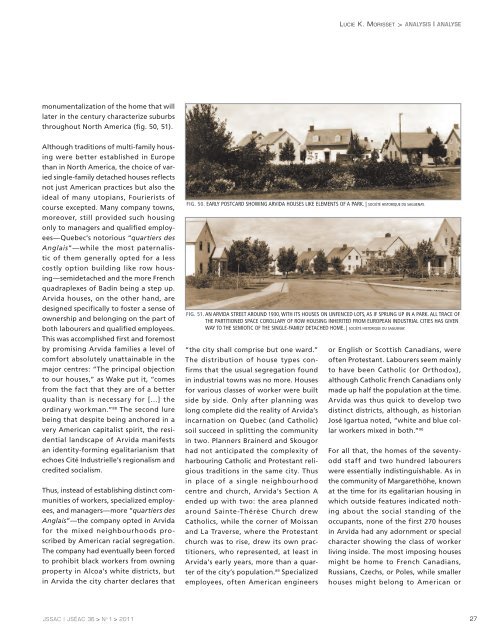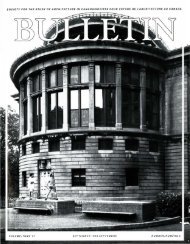'à es us e ct n s, es - Sexton Digtial Initiatives - Dalhousie University
'à es us e ct n s, es - Sexton Digtial Initiatives - Dalhousie University
'à es us e ct n s, es - Sexton Digtial Initiatives - Dalhousie University
Create successful ePaper yourself
Turn your PDF publications into a flip-book with our unique Google optimized e-Paper software.
monumentalization of the home that will<br />
later in the century chara<strong>ct</strong>erize suburbs<br />
throughout North America (fig. 50, 51).<br />
Although traditions of multi-family ho<strong>us</strong>ing<br />
were better <strong>es</strong>tablished in Europe<br />
than in North America, the choice of varied<br />
single-family detached ho<strong>us</strong><strong>es</strong> refle<strong>ct</strong>s<br />
not j<strong>us</strong>t American pra<strong>ct</strong>ic<strong>es</strong> but also the<br />
ideal of many utopians, Fourierists of<br />
course excepted. Many company towns,<br />
moreover, still provided such ho<strong>us</strong>ing<br />
only to managers and qualified employe<strong>es</strong>—Quebec’s<br />
notorio<strong>us</strong> “quartiers d<strong>es</strong><br />
Anglais”—while the most paternalistic<br />
of them generally opted for a l<strong>es</strong>s<br />
costly option building like row ho<strong>us</strong>ing—semidetached<br />
and the more French<br />
quadraplex<strong>es</strong> of Badin being a step up.<br />
Arvida ho<strong>us</strong><strong>es</strong>, on the other hand, are<br />
d<strong>es</strong>igned specifically to foster a sense of<br />
ownership and belonging on the part of<br />
both labourers and qualified employe<strong>es</strong>.<br />
This was accomplished first and foremost<br />
by promising Arvida famili<strong>es</strong> a level of<br />
comfort absolutely unattainable in the<br />
major centr<strong>es</strong>: “The principal obje<strong>ct</strong>ion<br />
to our ho<strong>us</strong><strong>es</strong>,” as Wake put it, “com<strong>es</strong><br />
from the fa<strong>ct</strong> that they are of a better<br />
quality than is nec<strong>es</strong>sary for […] the<br />
ordinary workman.” 88 The second lure<br />
being that d<strong>es</strong>pite being anchored in a<br />
very American capitalist spirit, the r<strong>es</strong>idential<br />
landscape of Arvida manif<strong>es</strong>ts<br />
an identity-forming egalitarianism that<br />
echo<strong>es</strong> Cité Ind<strong>us</strong>trielle’s regionalism and<br />
credited socialism.<br />
Th<strong>us</strong>, instead of <strong>es</strong>tablishing distin<strong>ct</strong> communiti<strong>es</strong><br />
of workers, specialized employe<strong>es</strong>,<br />
and managers—more “quartiers d<strong>es</strong><br />
Anglais”—the company opted in Arvida<br />
for the mixed neighbourhoods proscribed<br />
by American racial segregation.<br />
The company had eventually been forced<br />
to prohibit black workers from owning<br />
property in Alcoa’s white distri<strong>ct</strong>s, but<br />
in Arvida the city charter declar<strong>es</strong> that<br />
JSSAC | JSÉAC 36 > N o 1 > 2011<br />
“the city shall comprise but one ward.”<br />
The distribution of ho<strong>us</strong>e typ<strong>es</strong> confirms<br />
that the <strong>us</strong>ual segregation found<br />
in ind<strong>us</strong>trial towns was no more. Ho<strong>us</strong><strong>es</strong><br />
for vario<strong>us</strong> class<strong>es</strong> of worker were built<br />
side by side. Only after planning was<br />
long complete did the reality of Arvida’s<br />
incarnation on Quebec (and Catholic)<br />
soil succeed in splitting the community<br />
in two. Planners Brainerd and Skougor<br />
had not anticipated the complexity of<br />
harbouring Catholic and Prot<strong>es</strong>tant religio<strong>us</strong><br />
traditions in the same city. Th<strong>us</strong><br />
in place of a single neighbourhood<br />
centre and church, Arvida’s Se<strong>ct</strong>ion A<br />
ended up with two: the area planned<br />
around Sainte-Thérèse Church drew<br />
Catholics, while the corner of Moissan<br />
and La Traverse, where the Prot<strong>es</strong>tant<br />
church was to rise, drew its own pra<strong>ct</strong>itioners,<br />
who repr<strong>es</strong>ented, at least in<br />
Arvida’s early years, more than a quarter<br />
of the city’s population. 89 Specialized<br />
employe<strong>es</strong>, often American engineers<br />
Lucie K. Morisset > aNalysis | aNalyse<br />
fig. 50. eArly POstcArd shOwing ArvidA hO<strong>us</strong><strong>es</strong> like elements Of A PArk. | sOciété histOrique du sAguenAy.<br />
fig. 51. An ArvidA street ArOund 1930, with its hO<strong>us</strong><strong>es</strong> On unfenced lOts, As if sPrung uP in A PArk. All trAce Of<br />
the PArtitiOned sPAce cOrOllAry Of rOw hO<strong>us</strong>ing inherited frOm eurOPeAn ind<strong>us</strong>triAl citi<strong>es</strong> hAs given<br />
wAy tO the semiOtic Of the single-fAmily detAched hOme. | sOciété histOrique du sAguenAy.<br />
or English or Scottish Canadians, were<br />
often Prot<strong>es</strong>tant. Labourers seem mainly<br />
to have been Catholic (or Orthodox),<br />
although Catholic French Canadians only<br />
made up half the population at the time.<br />
Arvida was th<strong>us</strong> quick to develop two<br />
distin<strong>ct</strong> distri<strong>ct</strong>s, although, as historian<br />
José Igartua noted, “white and blue collar<br />
workers mixed in both.” 90<br />
For all that, the hom<strong>es</strong> of the seventyodd<br />
staff and two hundred labourers<br />
were <strong>es</strong>sentially indistinguishable. As in<br />
the community of Margarethöhe, known<br />
at the time for its egalitarian ho<strong>us</strong>ing in<br />
which outside featur<strong>es</strong> indicated nothing<br />
about the social standing of the<br />
occupants, none of the first 270 ho<strong>us</strong><strong>es</strong><br />
in Arvida had any adornment or special<br />
chara<strong>ct</strong>er showing the class of worker<br />
living inside. The most imposing ho<strong>us</strong><strong>es</strong><br />
might be home to French Canadians,<br />
R<strong>us</strong>sians, Czechs, or Pol<strong>es</strong>, while smaller<br />
ho<strong>us</strong><strong>es</strong> might belong to American or<br />
27

















